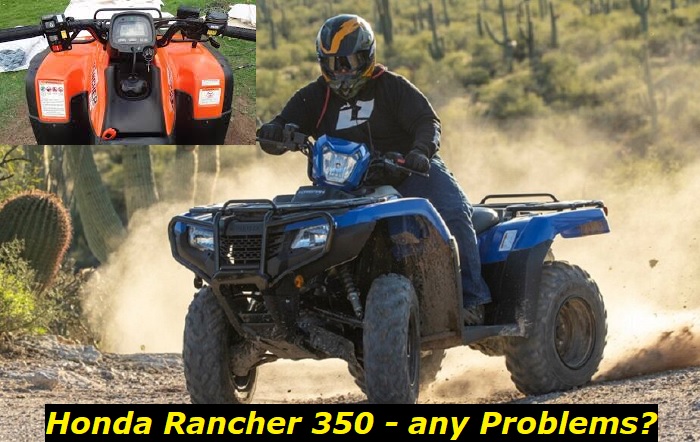The Honda Rancher 350 is one of the sturdiest and most exciting ATVs ever made. This model boasts advanced technology and is a product beyond people's expectations. Owning one of these matured and heavy-duty machines is a big boost to anyone's confidence. The Honda Rancher 350 is popular for synergizing function and durability.
As one of the first ATV models to showcase high-end features like the Electric Shift Program and electric steering, the Rancher 350 brings to the table ultramodern technology. It combines an amazing balance of handling, capacity, power, and size. The functionality of a Rancher 350 is one of the most popular among all types of ATVs.
Because of its compact build, the Honda Rancher 350 is often a wise alternative for a tractor. Tractors are usually more expensive and need intricate maintenance. That's why this portable Rancher comes in handy. With its tested and proven functionality and durability, the Honda Rancher 350 is one of the best-selling ATVs ever.

Since being introduced to the public in the year 2000, the Honda Rancher 350 has made the lives of countless people more convenient. The model is very popular among farmers but also appeals to people who prefer using its build for recreational purposes. The Rancher 350 was one of the first ATVs to utilize the longitudinally mounted motor.
Despite being one of the most reliable ATVs in town, the Honda Rancher 350 has its fair share of lapses. Things like steering problems and engine blubbers are common issues reported by users. Before getting into the thick of these issues, get to know what makes the Honda Rancher 350 the established name that it is today.
Honda Rancher 350 Features and Specifications
The introduction of the Rancher 350 cemented Honda's status as the world's top automobile and motorcycle manufacturer. This model was created as the answer to people's search for something that blends the looks of a smaller Recon and a larger Foreman. The following features and specifications of the Rancher 350 can give you relevant information on these powerful ATVs.
- Engine
The Rancher 350's engine is powered by an Otto cycle, single-cylinder, perfect for an off-highway vehicle. The engine is also mounted longitudinally giving more space for the rider. This design also reduces power loss for the drivetrain. It has a bore of 7.85 centimeters and a stroke of 68 millimeters.
- Drivetrain
The drivetrain includes a five-speed transmission and reverse gear. Like most Honda ATVs, the Rancher 350 model comes with the Electric Shift Program (ESP). With the ESP, you can switch the part-time 4WD system on and off with push-button ease.
- Ignition
An electric start system and an electronic CDI or Capacitor Discharge Ignition are embedded inside each Rancher 350 unit. In case backup is needed, it also has an auxiliary recoil pull starter. In case the starter of your Honda Rancher 350 breaks, you can easily restore it with the 2006 model of the Rancher 350.
- Tires and Brakes
The front wheels of the Ranger 350 are equipped with 24 X 8-12 tires and 24 X 9-11 tires at the rear, both of which are from Bridgestone. If you're aiming for speed, the Mud Lite AT series of ITP are bigger tires you could use as replacements. For the brakes, the front is equipped with hydraulic drum brakes, while the rear handle has a mechanical drum brake.
- Dimensions
The Honda Rancher 350 has a total length of 1.98 meters. It has a width of 1.14 meters and a height of 1.12 meters. The ground clearance is 18.29 centimeters, while the wheelbase is 1.25 meters. The dry weight of the Rancher 350 is around 238 kilograms, while its gross vehicle weight rating can reach up to 469 kilograms. In addition, the turning radius of 3.29 meters makes for greater spins and smoother handling.
- Suspension
A double-wishbone design and vertical control arms boosting the negative are the features of the front suspension. With this suspension type, there's a 5.9 inch-allowance of travel. Better balance and steady wheel alignment are also expected from these features. The suspension on the back end has an arm swing with a shock absorber that, like in the front suspension, allows 15 centimeters of travel.
- Lighting and Exterior
For superior light distribution, the Honda Rancher 350 has two halogen lights mounted on the front fenders. The handlebar light, which is 45 watts, also uses multi-reflector lenses. The exterior of the ATV is made up of a steel frame. This frame, combined with plastic components, makes the vehicle sturdy, lightweight, and trouble-free when cleaning. To protect your Honda Rancher 350 from too much snow or heat, you can buy a Weatherproof ATV Cover.
Most Prevalent Issues with the Honda Rancher 350
The Honda Rancher 350 has some of the latest technology available today. This particular ATV model is as durable as they come. As previously indicated, the Rancher 350's look and balance cause some to mistake it for a foreman.
Despite being the greatest alternative available, the Honda Rancher 350 has several difficulties that many users have reported. The most frequent issues owners have are listed here, along with potential solutions.
- Shifter Issues
There have been instances of the shift lever on some Honda Rancher 350 vehicles being stuck and malfunctioning. Additionally, the neutral indication is flashing twice. The brake light switch and indication are mostly responsible for this issue. The brake switch is turned on when one brake lever is touched. As the brake lights turn on, the neutral indicator blinks twice, acting as an error code for the electronic shift system.
You'll see that the brake lights themselves are not the issue if you pull the plug on the back of the car. There's a good chance they won't work once you start pulling the lever. The brake light will not function at all if the brake light switches on the brake lever are turned off, but the high beam will perform better as a result. The stop signs will vanish and the alarm will sound as well.
- Fuel and Carburetor Issues
The majority of gasoline and carburetor issues can be resolved by repeatedly cleaning the carburetor thoroughly. You must first take out the bowl, float, and float valve. Additionally, all injectors must be taken out to inspect the injector holes for obstructions. To clear out all obstructions, use a wire brush, but take care not to bend or damage the nozzle holes.
The lead screws may also need to be changed with compatible ones. Since improperly removing the old screws or mounting the new ones could damage the carburetor, this will be a delicate process. It will be crucial to count how many times the screw has been turned.
Blow air via the fuel inlet into the carburetor tubes. You can begin reinstalling the jets, the float, and the float needle, and replacing the vessel after checking the end of the floating needle hole that contains the needle for damage or debris. Reinstall the carburetor after finishing putting back in the other parts.
- Steering Problems
The steering wheel on some people's Rancher 350 has been described as being too tight. The majority of steering issues occur when driving between 5 and 10 miles per hour. The vehicle frequently accelerates too quickly in the desired direction as a result of the tight steering wheel. If the driver is not careful when this occurs, the Rancher 350 can destroy the person.
The majority of mechanics advise tweaking the tie rods to give the driver additional toe-out. This can help lessen the tenseness of the steering. Additionally, if the ball joints are excessively tight, you might examine them. To see if the issue is genuine with the ball joints, try to detach the tie rods from the knuckles. Applying grease and oil will loosen up any stiffness and will make them easier to turn back and forth.
- Throttle and Engine Problems
There are reports about Honda Rancher 350 units frequently cutting off at half throttle. This often results in the engine blubbing. Many experts agree that this problem is frequently brought on by improper valve clearances and compression. To fix the issue, a majority of drivers remove the air box. This short-term fix, though, might cause further harm to the engine and the Rancher's general performance.
When washing the Rancher, removing the air box can cause water to enter the carburetor or potentially the motor. Replace the spark plug instead to avoid this ineffective troubleshooting procedure. Additionally, check to see that the slide slides freely, the air box is intact, and the choke valve is fully placed.
Conclusion
The Honda Rancher 350 is a magnificent machine that will certainly meet all your needs. It's functional and could still give you a satisfying trail riding experience. It's less expensive compared to larger ATVs, and its rugged but reliable style makes it a cut above the rest. The Rancher 350's ingenious features, advanced technology, and durability are everything you'd want from a utility vehicle.
About the authors
The CarAraC research team is composed of seasoned auto mechanics and automotive industry professionals, including individuals with advanced degrees and certifications in their field. Our team members boast prestigious credentials, reflecting their extensive knowledge and skills. These qualifications include: IMI: Institute of the Motor Industry, ASE-Certified Master Automobile Technicians; Coventry University, Graduate of MA in Automotive Journalism; Politecnico di Torino, Italy, MS Automotive Engineering; Ss. Cyril and Methodius University in Skopje, Mechanical University in Skopje; TOC Automotive College; DHA Suffa University, Department of Mechanical Engineering






Add comment